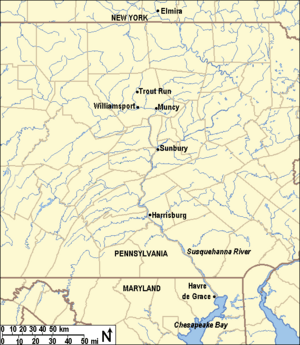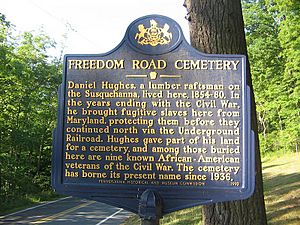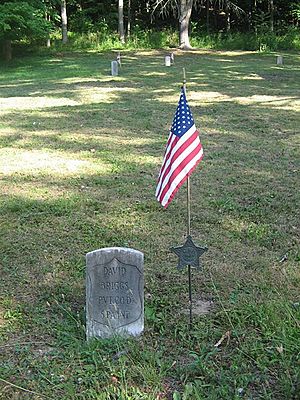Daniel Hughes (underground railroad) facts for kids
Quick facts for kids
Daniel Hughes
|
|
|---|---|
 |
|
| Born | 1804 |
| Died | 1880 |
| Occupation | Lumber raftsman and Underground Railroad conductor |
| Height | 6 ft 8 in (2.03 m) |
| Spouse(s) | Ann Rotch |
| Children | 16 |
Daniel Hughes (1804–1880) was a very important person in the Underground Railroad. He helped many enslaved people find freedom. He lived in Loyalsock Township, Lycoming County, Pennsylvania.
Daniel owned a special boat called a barge. He used it to carry wood from Williamsport to Havre de Grace, Maryland. On his way back, he secretly hid people escaping slavery in his barge. He brought them to his home in Lycoming County. From there, they continued their journey north to Canada, where they could finally be free. His home was in a hidden valley, now called Freedom Road.
Daniel Hughes was a man of mixed heritage. The official records from 1850 described him as "mulatto," meaning he had both Black and white ancestors. He was also partly Mohawk. He was very tall for his time, standing 6 feet 8 inches. He weighed about 300 pounds. In 1828, Daniel moved to Williamsport. He married Ann Rotch, a free African American woman. She was also described as "mulatto." His job on the river and canals was perfect for his secret work with the Underground Railroad. His barge and home were safe places for those seeking freedom.
Contents
Who Was Daniel Hughes?
Daniel Hughes was a key figure in the Underground Railroad. This was a secret network of safe houses and routes. It helped enslaved African Americans escape to freedom. People like Daniel, who guided the escapees, were called "conductors." His home was a "station," a safe stop along the way.
Daniel's property was in a very wooded area. It had thick vines and even caves. These natural hiding spots helped keep the runaway slaves safe. He and his family worked hard to keep their activities secret.
Dangers on the Road to Freedom
Even though slavery was not allowed in Pennsylvania, Daniel's work was still very dangerous. Not everyone in his town agreed with helping enslaved people. Daniel, his wife, and their 16 children had to be very careful.
A law called the Fugitive Slave Act of 1850 made things even harder. This law allowed slave catchers to come into northern states to find people who had escaped. Before this, they usually had to stop at the Mason-Dixon line. This new law made life much more risky for everyone involved in the Underground Railroad.
There were also strong disagreements about slavery in Lycoming County. Daniel and his sons often worked at night when there was no moon. This made it harder for slave catchers to see them. They even stretched horse hairs across trails. These were hard to see and could make slave catchers fall off their horses. This slowed them down or made them give up.
Daniel would lead the freedom seekers from his home to the next safe stop. This was in Lewis Township, near a place called Trout Run. From there, they would travel north to Elmira, New York. Eventually, they would reach Canada and be truly free.
A Son's Memories
Daniel Hughes' son, Robert, later shared many stories about their work. He remembered hiding people in "brush houses" in the woods. Even as a small boy, he carried food out to them. He said the escapees usually traveled in small groups of two or three men.
Robert also recalled that "patrollers" (people looking for runaway slaves) often came to their home. But they never caught anyone there. He said that "rich people and good people in Williamsport," especially Quakers, also helped with their important work.
Helping His Community
Daniel Hughes also helped the African American community in Williamsport in another way. He gave some of his land to be used as a cemetery. This cemetery is now a historic site. Nine African American veterans of the American Civil War are buried there.
Daniel Hughes himself is buried in an unmarked grave in this cemetery. This was his wish.




